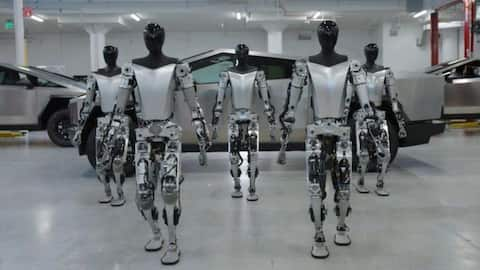How Tesla's humanoid robot has evolved since last year's unveiling
What's the story
Tesla's humanoid robot could soon become a reality. At its annual shareholder meeting, the company shared a video featuring its 'Optimus' bipedal robot performing tasks like walking, recognizing things, and picking up objects. This makes it far superior to the prototype showcased last year, which was incapable of any work. So, how has Optimus evolved since its unveiling? Let us find out.
Inception
The journey started in 2021
Back in 2021, CEO Elon Musk announced that Tesla was working on a "friendly" humanoid robot. It would be five feet and eight inches tall, have a screen on its face, and weigh around 57kg. The bot would leverage the firm's Autopilot driver assistance software and would be used for "unsafe, repetitive, or boring" tasks. It seemed like a cool idea at that time.
Prototype
Optimus got the skills to wave hands in 2022
Last year, Musk revealed the prototype version of the Optimus robot. He claimed that it shared certain sensors and AI software with Tesla's Autopilot. The robot could operate without a tether and wave its human-like hands. It housed a 2.3kWh battery, offered Wi-Fi and LTE connectivity, and ran on a Tesla SoC. However, walking was impossible. It took another year to refine it further.
Present
What can Optimus do now?
Now, Optimus can walk slowly (as if there's a pinched nerve in its back), demonstrate motor torque control (ability to change hand grip strength), and explore/memorize environments thanks to onboard cameras and sensors. AI training from "human-tracked movements" is also possible. It has also demonstrated the ability to deal with various objects using its hands. Such tasks are very difficult for humanoid robots.
Information
What about its pricing and availability?
The Optimus is expected to cost less than $20,000 (around Rs. 16.5 lakh) in the US market. The robot will probably head to production, once Tesla commences deliveries of its highly-anticipated Cybertruck.
Future
What's the way ahead?
Tesla claims that Optimus might revolutionize its manufacturing and assembly line business, and serve as a "fundamental transformation for civilization." The robot will head to mass production in "millions" of units and might replace labor-intensive workforces one day. However, it remains to be seen how Optimus will fare against Atlas, Boston Dynamics's far more advanced humanoid robot that can run, climb, and much more.
